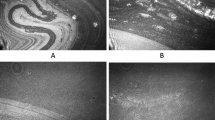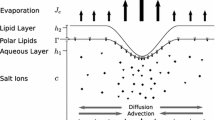Abstract
Blinking involves high rates of shear within the tear film, requiring a low tear viscosity to avoid damage to epithelial surfaces. Conversely, in the open eye, a higher viscosity is desirable to resist drainage and film break-up. Samples of human tears were collected with moderate stimulation from 5 adult males, 3 with normal and 2 with marginally-dry eyes. The apparent viscosity at 22° C was found using a Couette-type rheometer over the range of shear rate 2–160 sec-1. Marked shear-thinning was apparent in all samples, with little apparent difference between normal and dry-eye tears. Although a power-law equation could be fitted over part of the range, analyses according to either the Casson plastic model as used for rabbit tears (with a low yield-point indicative of some very loose initial gel-like structure) or the Steiger-Ory model (a true pseudoplastic model with no initial yield point) were inconclusive over the range of shear rate studied. The descriptive model of Cross gave zero-shear viscosity values of 4.4, 7.1 and 8.3 mPa. sec for normal tears, and 27.1 and 31.1 mPa.sec for dry-eye tears; the corresponding time constants were 0.13, 0.27 and 0.38 sec for normal tears, and 2.7 and 2.9 sec for dry-eye tears. These time-constants can be considered as an approximate relaxation time, indicating the time taken for the tear film to stabilise after a blink.
Similar content being viewed by others
References
Carpenter, RHS. Movements of the eyes. 2nd ed. London: Pion, 1988: 55–131.
Kestenbaum, A. Applied anatomy of the eye. New York: Grune and Stratton, 1963: 20.
Ehlers, N. The precorneal film. Biomicroscopical, histological and chemical investigations. Acta Ophthalmol (Copenh) 1965; Supp 81: 1–136.
Prydal, J. The structure and thickness of the tear film. Invest Ophthalmol Vis Sci 1989; 30 Supp: 470.
Doane, MG. Interaction of eyelids and tears in corneal wetting and the dynamics of the normal human eyeblink. Am J Ophthalmol 1980; 89: 507–16.
Kaura, R, Tiffany, JM. The role of mucous glycoproteins in the tear film. In: Holly, FJ, ed. The preocular tear film. Lubbock, Texas: Dry Eye Institute, 1986: 728–32.
Hamano, H, Mitsunaga, S. Viscosity of rabbit tears. Jpn J Ophthalmol 1973; 17: 290–9.
Bron, AJ, Mengher, LS. The ocular surface in keratocon-junctivitis sicca. Eye 1989; 3: 428–37.
Dudinski, O, Finnin, BC, Reed, BL. Acceptability of thickened eye drops to human subjects. Curr Therap Res 1983; 33: 322–37.
Bothner, H, Waaler, T, Wik, O. Rheological characterization of tear substitutes. Drug Dev Indust Pharm 1990; 16: 755–68.
Bron, AJ, Tiffany, JM. Pseudoplastic materials as tear substitutes: an exercise in design. The Lacrimal System. A selection of papers presented at the 6th International Symposium on the Lacrimal System, Singapore, March 17, 1990. eds van Bijsterveld, OP, Lemp, MA, Spinelli, D. Amsterdam: Kugler & Ghedini, 1991: 27–33.
Tiffany, JM, Winter, N, Bliss, G. Tear film stability and tear surface tension. Curr Eye Res 1989; 8: 507–15.
Mengher, LS, Bron, AJ, Tonge, SR, Gilbert, DJ. A noninvasive instrument for clinical assessment of the precorneal tear film stability. Curr Eye Res 1985; 4: 1–7.
Cross, MM. Analysis of flow data on molten polymers. Eur Polymer J 1966; 2: 299–307.
Tiffany, JM. Rheology of tears and tear substitutes. In: 4th. Workshop on External Eye Disease and Inflammation. Loughborough, UK: Fisons, 1990: 33–38.
Author information
Authors and Affiliations
Rights and permissions
About this article
Cite this article
Tiffany, J.M. The viscosity of human tears. Int Ophthalmol 15, 371–376 (1991). https://doi.org/10.1007/BF00137947
Issue Date:
DOI: https://doi.org/10.1007/BF00137947




